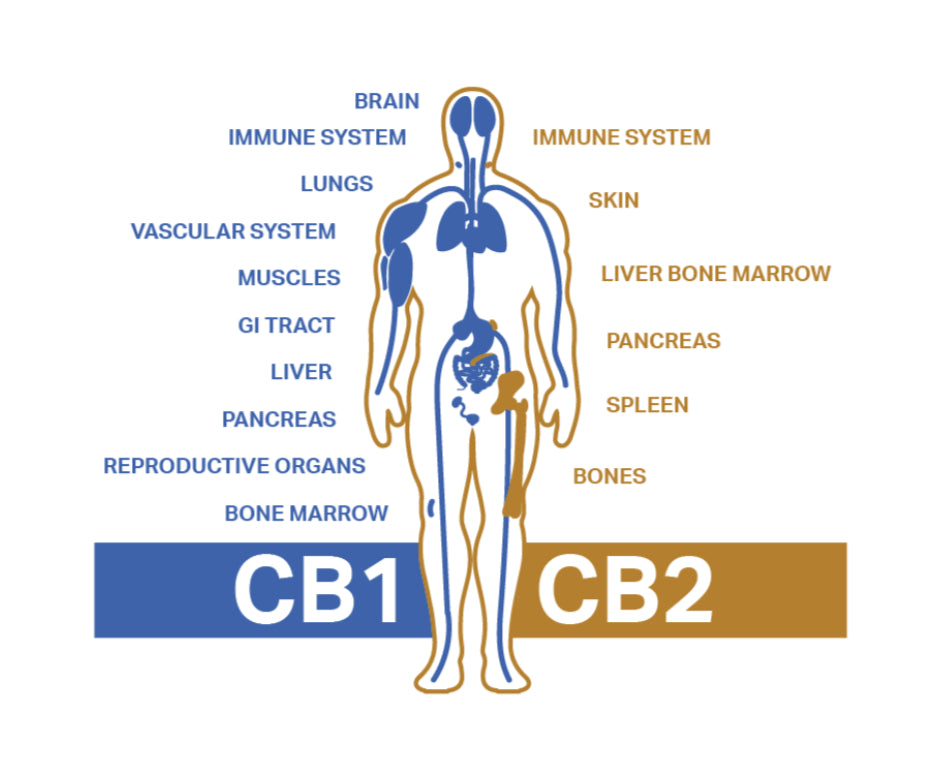
The ECS is a complex cell-signaling system in our body that helps regulate key functions like mood, pain, sleep, appetite, and immune response. It consists of receptors (CB1 and CB2), endocannabinoids (like anandamide and 2-AG), and enzymes that break them down. The ECS maintains balance (homeostasis) and responds to both internally produced and external cannabinoids (like THC and CBD).
-

CB1 Receptors
Found primarily in the brain and nervous system, affecting mood, pain, and memory -

CB2 Receptors
Located in immune tissues and organs, regulating inflammation and immunity
Key Discovery Timeline
Understanding the ECS
The Endocannabinoid System consists of receptors, endocannabinoids, and enzymes that work together to maintain balance (homeostasis) and respond to both internal and external cannabinoids.
Cannabinoid Deep Dive
Understanding the unique properties and benefits of each cannabinoid
THCV
Energy, Focus, and Appetite Control
Tetrahydrocannabivarin (THCV) is a cannabinoid that stands out for its energizing and focusing effects, making it an excellent choice for those looking to enhance productivity and mental clarity. Unlike THC, which is known for stimulating appetite (commonly referred to as "the munchies"), THCV has the opposite effect, helping to suppress appetite. This makes it a great option for anyone interested in maintaining focus and controlling appetite throughout the day. If you're reaching for a sativa to boost your energy levels, you might actually be better served by a product rich in THCV.
CBDV
Memory, Sociability, and Focus
Cannabidivarin (CBDV) is another cannabinoid that deserves more attention. Similar to CBD, CBDV is non-psychoactive and offers a range of effects that are particularly helpful for improving memory, increasing sociability, and reducing irritability. It's also known to enhance focus and alertness, making it a perfect complement to THCV when you need to stay sharp and engaged. While CBD products are often chosen for relaxation, CBDV can provide a balanced experience that keeps you both calm and clear-headed.
CBN
Relaxation and Sleep
Cannabinol (CBN) is gaining popularity as a go-to cannabinoid for relaxation and sleep. When considering sativa vs. indica strains, people traditionally think of indica as promoting sleep and a "couch-lock" feel. While traditional indica strains are often recommended for winding down, CBN offers a more targeted approach. Known for its sedative properties, CBN is ideal for those looking to enhance their nighttime routine. It's worth considering CBN-infused products over simply relying on indica strains for better sleep quality.
CBG
Relief from Discomfort and Tension
Cannabigerol (CBG) is often referred to as the "mother of all cannabinoids" because it serves as a precursor to THC, CBD, and other cannabinoids. CBG is particularly effective for easing discomfort and tension in muscles and joints. Whether you're dealing with post-workout soreness or everyday muscle tension, CBG can provide targeted relief. Instead of choosing an indica or hybrid strain for these effects, consider a product high in CBG for more effective relief.
CBC
Mood Enhancement and Skin Health
Cannabichromene (CBC) is another cannabinoid that offers unique benefits. CBC is known to elevate mood by increasing levels of anandamide, often called the "bliss molecule." This makes CBC particularly effective for improving overall well-being and happiness. Additionally, CBC has been shown to promote healthy skin. For anyone seeking to enhance their mood or improve skin health, a product rich in CBC could be more beneficial than a strain classified as sativa or hybrid.
CBD & Cannabinoid Guide
Confused by cannabis terms like THC, CBD, CBN, or THCV? We've got you covered! This quick guide breaks down everything you need to know—no jargon, just clear, fun explanations.
Key Terms
Anandamide
The "bliss molecule" your body makes when you're happy! Hemp cannabinoids (like CBD, CBC, and THC) may boost it.
Broad-Spectrum CBD
Full-spectrum CBD with zero THC—keeps all the good stuff (terpenes, minor cannabinoids) without the high.
CBD (Cannabidiol)
The superstar non-psychoactive compound in hemp. Used for stress, discomfort, and relaxation. Comes in oils, gummies, creams, and more.
Cannabinoids
Active compounds in hemp/cannabis (over 100 types!). CBD & THC are the most famous, but CBN, CBG, THCV have unique perks (sleep, energy, appetite control).
THC (Delta-9-THC)
The high-inducing cannabinoid in cannabis. Also found in tiny amounts (<0.3%) in legal hemp products.
Rare Cannabinoids
CBN
The "sleepy" cannabinoid (great for relaxation).
THCV
Like THC's energizing cousin—curbs appetite & boosts focus.
CBG
The "mother of cannabinoids," helps with discomfort and calm.
CBC
Elevates mood by boosting anandamide (the bliss molecule).
Popular Products
CBD Gummies
Tasty, easy doses of CBD for stress relief.
CBN Gummies
Nighttime favorites for deeper sleep.
THCV Gummies
For energy and appetite control.
CBD Cream
Soothes muscles and skin.
How the ECS Maintains Balance
Key Functions Regulated:
- ✔ Mood and emotional response
- ✔ Pain perception and management
- ✔ Sleep-wake cycles
- ✔ Appetite and metabolism
System Response:
- ✔ Immune system modulation
- ✔ Inflammation control
- ✔ Memory and learning
- ✔ Homeostasis maintenance
The Entourage Effect
The entourage effect refers to the enhanced benefits when multiple cannabis compounds (like cannabinoids, terpenes, and flavonoids) work together rather than in isolation. For example, CBD may modulate THC’s psychoactive effects, while terpenes like myrcene or limonene can amplify therapeutic outcomes. This synergy is why full-spectrum cannabis products are often more effective than isolated compounds.
Synergistic Benefits
When cannabinoids, terpenes, and flavonoids work together, they create enhanced therapeutic outcomes that surpass what any single compound could achieve alone.
- ★ CBD may modulate THC's psychoactive effects
- ★ Terpenes like myrcene enhance relaxation
- ★ Limonene can amplify mood-lifting effects
Why Full-Spectrum Works Better
This synergy is why full-spectrum cannabis products are often more effective than isolated compounds. The whole plant works together as nature intended.
Key Compounds Working Together
Cannabinoids
CBD, THC, CBG, CBN, CBC, THCV, and more
Terpenes
Myrcene, limonene, pinene, linalool
Flavonoids
Quercetin, apigenin, cannflavin A & B
Other Phytonutrients
Essential oils, fatty acids, and proteins
Spectrum Comparison Guide
Understanding the differences between Full-Spectrum, Broad-Spectrum, and Isolate products
Full-Spectrum
THC Content: ≤0.3%
Cannabinoids: All
Terpenes: Naturally preserved
Entourage Effect: Strongest
- Complete entourage effect
- Trace amounts of THC
- All minor cannabinoids
- Rich in terpenes & flavonoids
- Closest to natural plant profile
Broad-Spectrum
THC Content: 0%
Cannabinoids: Most (no THC)
Terpenes: Usually preserved
Entourage Effect: Moderate
- No THC detection risk
- Still promotes entourage effect
- Multiple cannabinoids present
- Terpenes often reintroduced
- THC-free but holistic benefits
Isolate
THC Content: 0%
Cannabinoids: Single
Terpenes: None (unless added)
Entourage Effect: None
- 99%+ pure single cannabinoid
- No other compounds
- Tasteless and odorless
- Predictable dosing
- No entourage effect
Entourage Effect & Key Facts
Did You Know?
- • THCA (raw cannabis) turns into THC when heated
- • Delta-8 & Delta-10 THC are hemp-derived, milder THC alternatives
- • Terpenes give cannabis its smell and effects (e.g., linalool = calming, limonene = uplifting)
- • Farm Bill 2018 made hemp (and CBD) federally legal (if <0.3% THC)
Entourage Effect
Cannabinoids + terpenes work better together! This synergistic effect enhances therapeutic benefits.
Final Note: If terpenes are important for your needs (e.g., relaxation, focus, pain relief), full-spectrum or broad-spectrum are better choices than isolate.
Terpene Preservation by Spectrum Type
Full-Spectrum
Highest terpene integrity - closest to natural plant profile
Broad-Spectrum
Terpenes may be lost during THC removal but often reintroduced
Isolate
No terpenes unless added later (common in "terpsolate" products)
The Power of Terpenes
Terpenes are the secret sauce in hemp and cannabis—they're aromatic compounds that give plants their unique scents (like citrus, pine, or lavender) and amplify the effects of cannabinoids. Think of them like the bassline in a song—they make everything hit harder!
Why Terpenes Matter
- • Entourage Effect: Terpenes team up with cannabinoids (like CBD, THC) to enhance their effects.
- • Natural Aromatherapy: Even without cannabinoids, terpenes can influence mood (e.g., lavender's linalool for relaxation).)
Nature's Aromatherapy
Terpenes are found throughout nature—not just in cannabis. The same compounds that make lemons smell citrusy, pine trees smell fresh, and lavender smell calming are working synergistically with cannabinoids to create enhanced therapeutic effects.
Learn More About Cannabinoids
This guide provides educational information about cannabinoids and terpenes. Always consult with healthcare professionals before using any hemp or cannabis products.
📄 Lab Reports (COA)
Every product should have its own Certificate of Analysis showing absence of heavy metals, pesticides, and cannabinoid levels. Federal law allows <0.3% Delta-9 THC by weight.
⚖ Legal Notice
Hemp-derived products with <0.3% Delta-9 THC are federally legal under the 2018 Farm Bill. State laws may vary.





